SCOUTED: Scouting the J.League
.png)
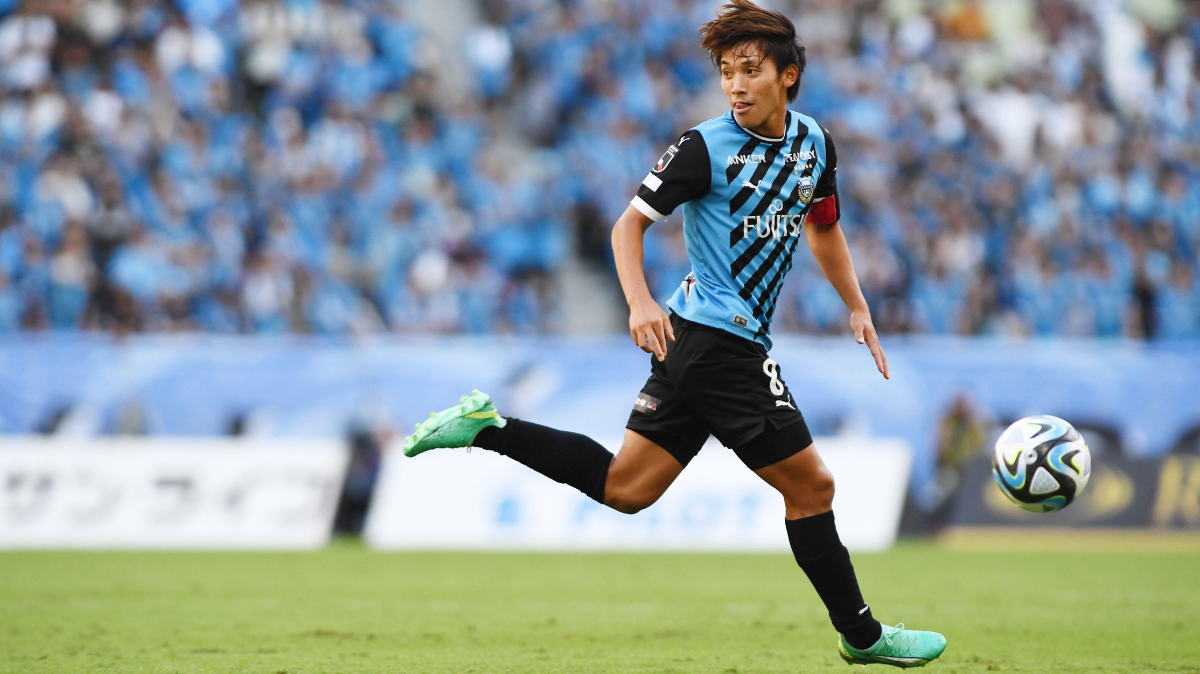
SkillCorner has partnered with Scouted Football, providing data and insights to support their writing on the best emerging talent in football.
In this article, the Scouted team uses our Physical and Game Intelligence data to analyse the J.League and some of its top players.
If you’ve been following the transfer world over the past few years, you’ll have noticed the J.LEAGUE’s rise as a popular market for European clubs to do their shopping.
Top flight Japanese football is growing at an exponential rate. Gone are the days of it being a niche interest and dare I say insular spectacle; it’s now one of the trendiest corners of the world to shop in.
Some of its boom in popularity can be attributed to the extraordinary success of Kaoru Mitoma at Brighton & Hove Albion, but the league is rich in tradition, culture, atmosphere, talent and quality. Watch any J.LEAGUE game and you will be taken aback by the top-level football and die-hard fans on display.
The J.LEAGUE is good. Like, properly good. As Steve highlighted in his exceptional Revolution Asia piece, Japanese football compares favourably to Europe’s elite leagues when it comes to athleticism and intensity – just look at the scatter graph below.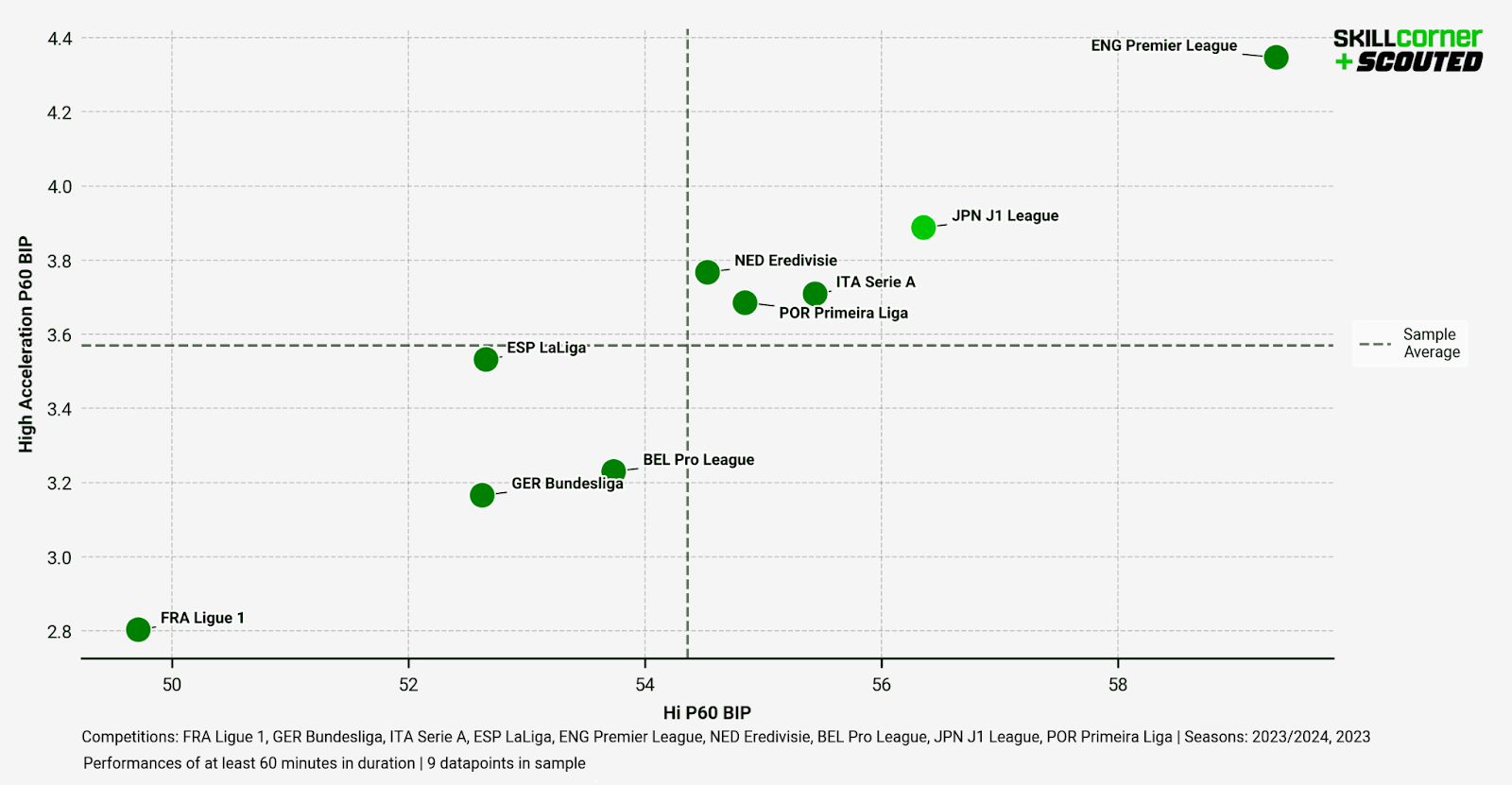
The J.LEAGUE’s speed and intensity – which ranks above the likes of Serie A, even – means its exports are much more likely to handle the rigours of the European games than the exports of any other Asian league. In most cases, they’re moving to leagues that are actually slower and less intense.
The ever-efficient German (and Red Bullian) clubs had the monopoly on the market for much of the past decade – picking up the likes of Shinji Kagawa, Takumi Minamino, and so on – but the client base has rapidly expanded throughout Europe to include Belgium, the Netherlands, England, Italy, and even Scandinavia and Scotland.
If you’ve not got the Japanese market covered, you’re doing something wrong. That’s where we come in. I’ve already picked out five players you should be watching in the 2024 season and now I’ll use unique SkillCorner data to highlight another handful of J.LEAGUE stars that are ready to make the leap to Europe.
As with my piece that focussed on Spain’s Segunda División, I’ll be looking for certain profiles using SkillCorner’s extensive suite of data. They include:
- A press-resistant midfielder
- An athletic centre-back
- Dynamic, overlapping full-backs
- Run-making, goal-scoring centre-forwards
Given that Japanese players tend to make that leap a little later than the norm, I’ve placed the emphasis on players aged 26-and-under, rather than the SCOUTED-approved 23-and-under.
Before we get going, I should note that we’re using data from the 2023 J.LEAGUE season. Why? Because it gives us a bigger pool of players and a much larger dataset, rather than the eight-odd games from the 2024 campaign. Let’s crack on.
1. All-important press-resistant midfielder
Where better to start than with perhaps the most popular (and valuable, maybe, but that’s an idea for another SkillCorner piece) profile in the modern age of football?
To find a press resistant midfielder, I’ve utilised SkillCorner’s Dealing With Pressure data suite. Basically, there’s a whole range of metrics that quantifies how well a player operates under pressure. It’s calculated by the speed and distances from which an opponent approaches the player in possession.
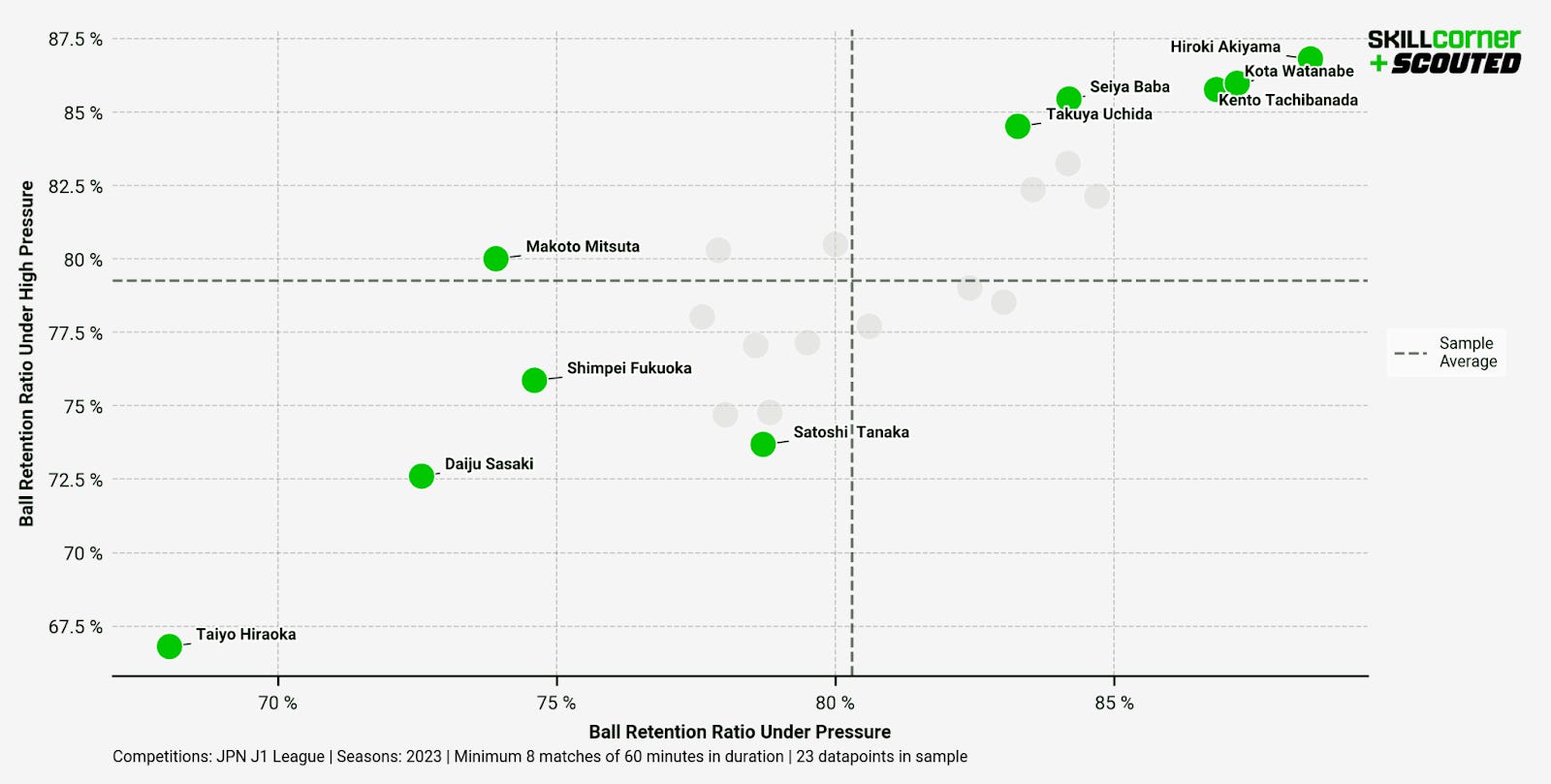
Three players jump off the page immediately: Hiroki Akiyama (2000, Albirex Niigata), Kento Tachibanada (1998, Kawasaki Frontale) and Kota Watanabe (1998, Yokohama F Marinos).
They rank at the exceptional end of the ball retention under pressure scatter graph, nestling on a little tier of their own excellence among J.LEAGUE midfielders born in 1998 or later. It picks them out as the best of an admittedly small subset.
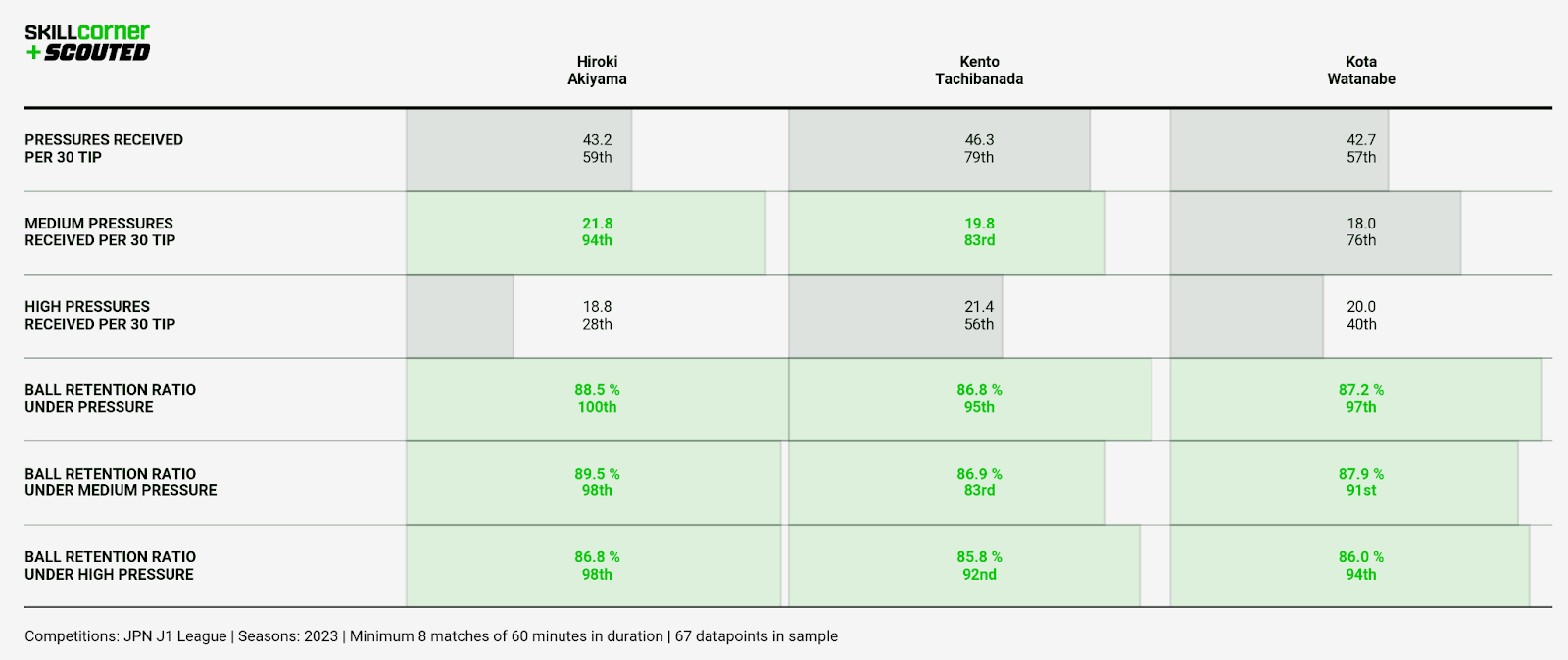
You’re probably screaming “but what happens when we compare them against a significantly larger pool that includes every J.LEAGUE midfielder that played 60+ minutes in eight different games during the 2023 season, Llew?” Well, they still stand out: Akiyama, Tachibanada and Watanabe all rank in the 90th percentile or above for handling total pressure, medium pressure and high pressure. We can safely deduce that they’re good under pressure.
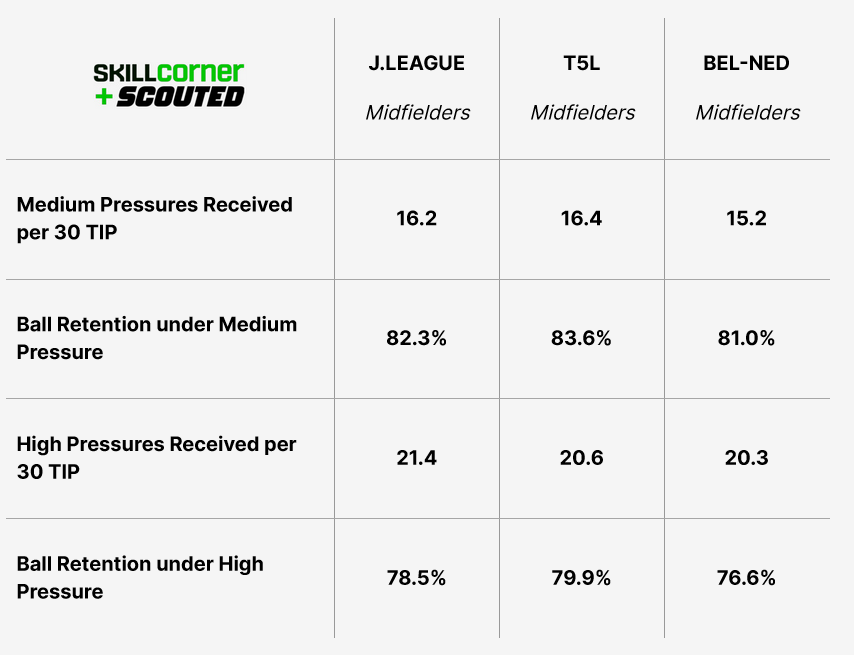
Compare them to the benchmarks in the J.LEAGUE, Europe’s top-five leagues and the most popular landing spots for Japanese players (the Belgian Pro League and Dutch Eredivisie) and you can see that Akiyama, Tachibanada and Watanabe are still standouts. All that said, projecting how these press-resistant midfielders would translate to those leagues is the money-maker (and a subject for another in-depth analysis).
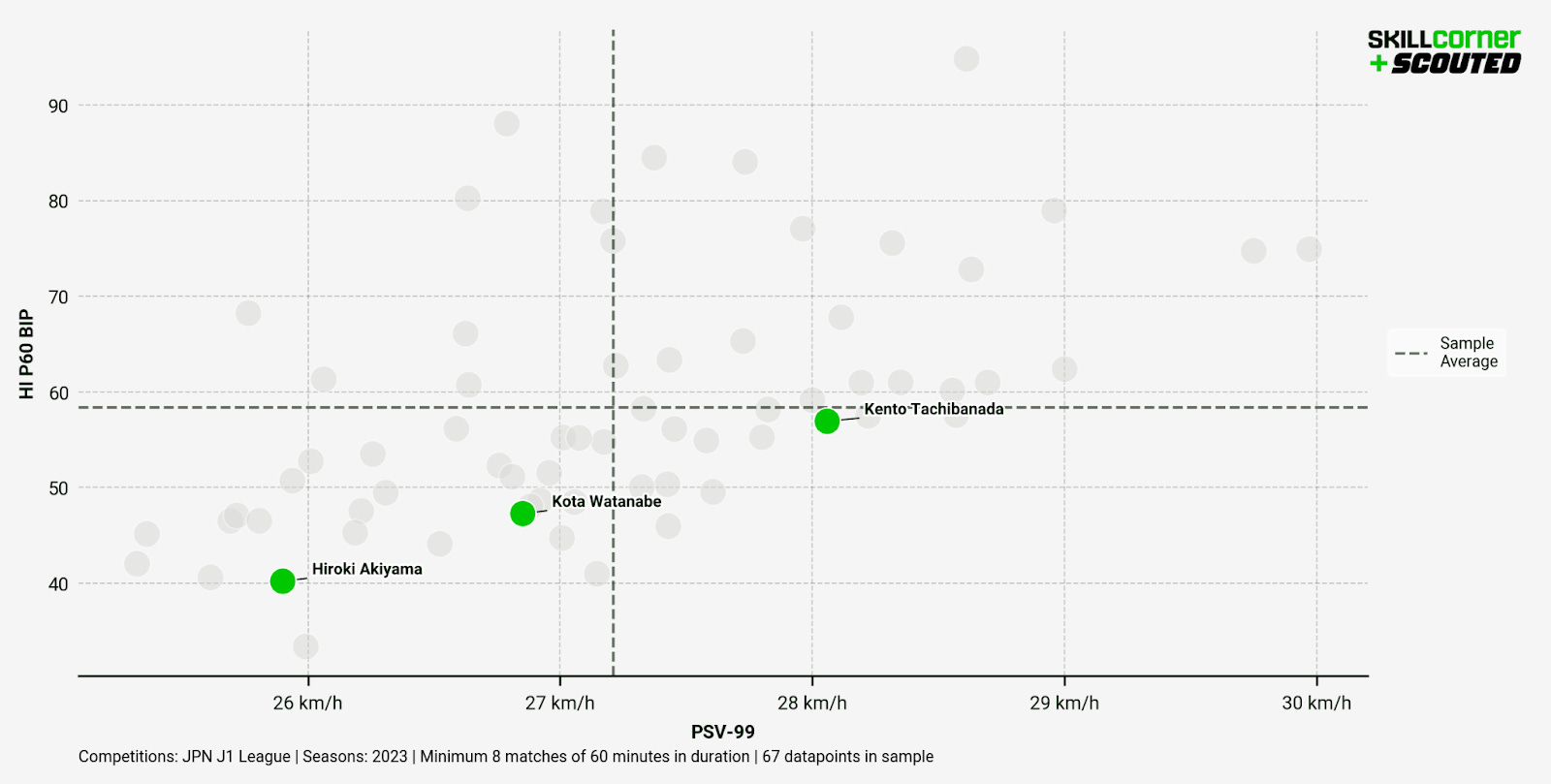
There’s more to being a midfielder than just being good under pressure. You have to be athletic for one, particularly if you have ambitions to play at the highest levels of the European game. Kawasaki Frontale’s Tachibanada is the only one of this select three that ranks above the average when it comes to speed and intensity. That’s something that clubs will have to assess for themselves within their own parameters.
2. An athletic centre-back
Japanese football has produced a number of good centre-backs in recent years. Takehiro Tomiyasu is the pick of them; he moved through Belgium and Bologna to reach the top of the Premier League tree at Arsenal. Hiroki Ito and Ko Itakura are doing well in the Bundesliga, Koki Machida has been a stalwart at Union Saint-Gilloise, and there’s more, too.
An important attribute in a centre-back is pace. As teams defend higher up the pitch, you need defenders that have the recovery speed to tidy up behind the back line. If you’re quick, you can go far – that’s why I’ve placed the emphasis on PSV-99, SkillCorner speed metric, for this one.
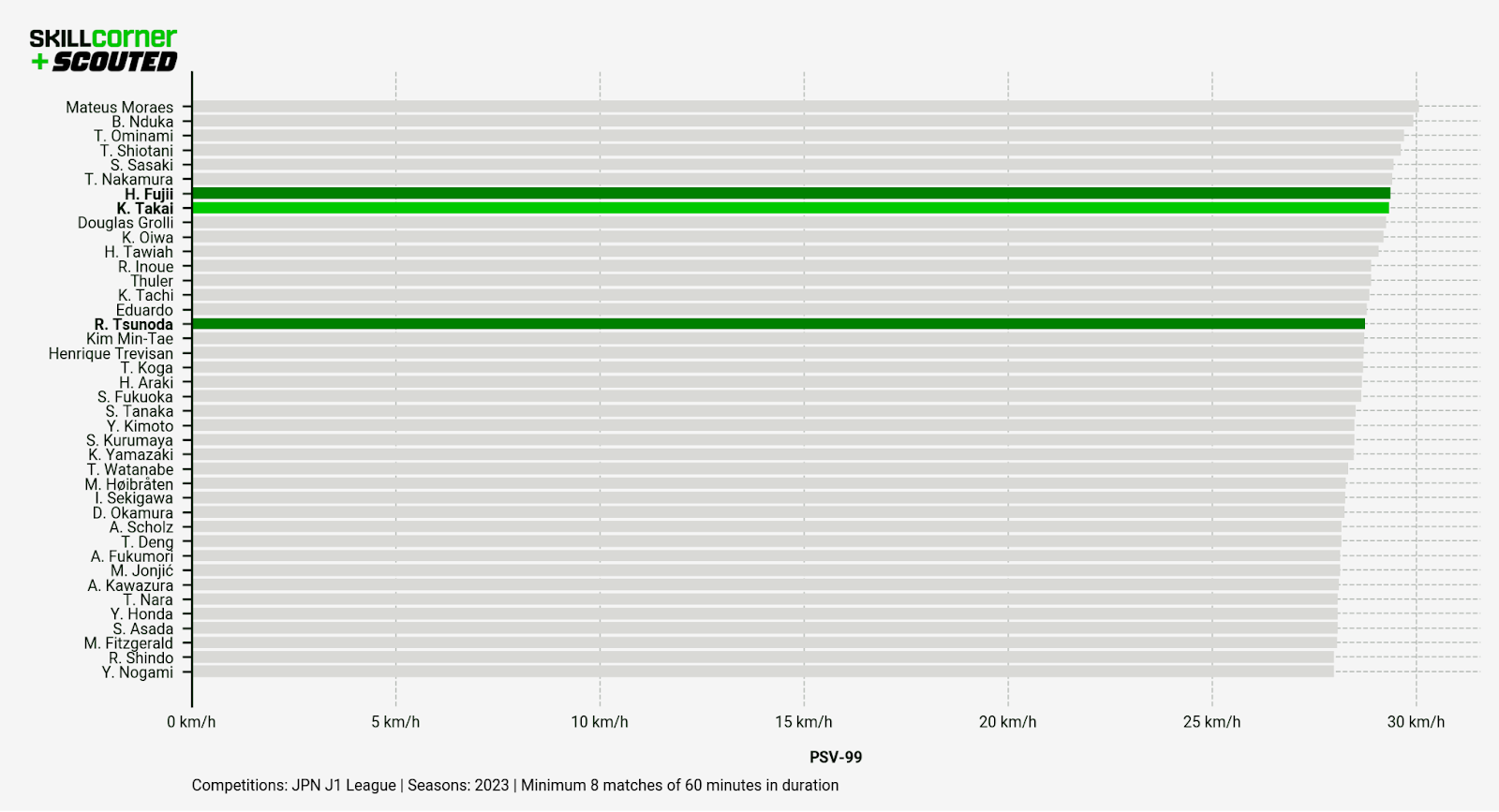
A couple stand out from this PSV-99 bar graph. The first is in the lighter green, Kota Takai. He’s an emerging talent I highlighted in that J.LEAGUE piece I did the other month. I said this:
“On the pitch, perhaps his most obvious attribute is his height: Takai stands at 1.92 metres, according to Transfermarkt, which translates to about 6’3”. That’s considerably above the average in Japanese football. Despite his size, Takai moves pretty well - he’s not the fastest nor the most agile, but he’s spry enough to cover space effectively and has a decent leap.”
I was right: he isn’t the fastest, but he’s pretty fast, fast enough, and he’s only 19 years old.
The other two of note in this graphic are those highlighted in the darker green, Haruya Fujii and Ryotaro Tsunoda. They’re important because both are 23-and-24-year-old central defenders, J.LEAGUE regulars and senior Japanese internationals that have made the leap to Europe this winter, joining KV Kortrijk in Belgium. Both immediately stepped into the first team, playing full nineties in every game to date (or at least until Fuji’s thigh muscle blew up).
That’s the sort of trajectory Takai can follow, especially with his promising defensive abilities and high-level ball-playing capabilities. Seeing him mix it with the best in terms of pure speed on SkillCorner data has only strengthened that expectation of mine.
3. The dynamic, overlapping full-back
Believe it or not, there’s still a place for the traditional full-back in modern football. The current trend sees them tuck inside to help with build-up, but plenty of teams are still looking for the drive and intensity of an up-and-down overlapper.
SkillCorner have a metric for this, obviously, in their Off-ball Runs suite. You can pick out players for the types of runs they make, from overlaps and underlaps to runs behind the defensive line and those that drop short toward the ball, and a whole lot more.
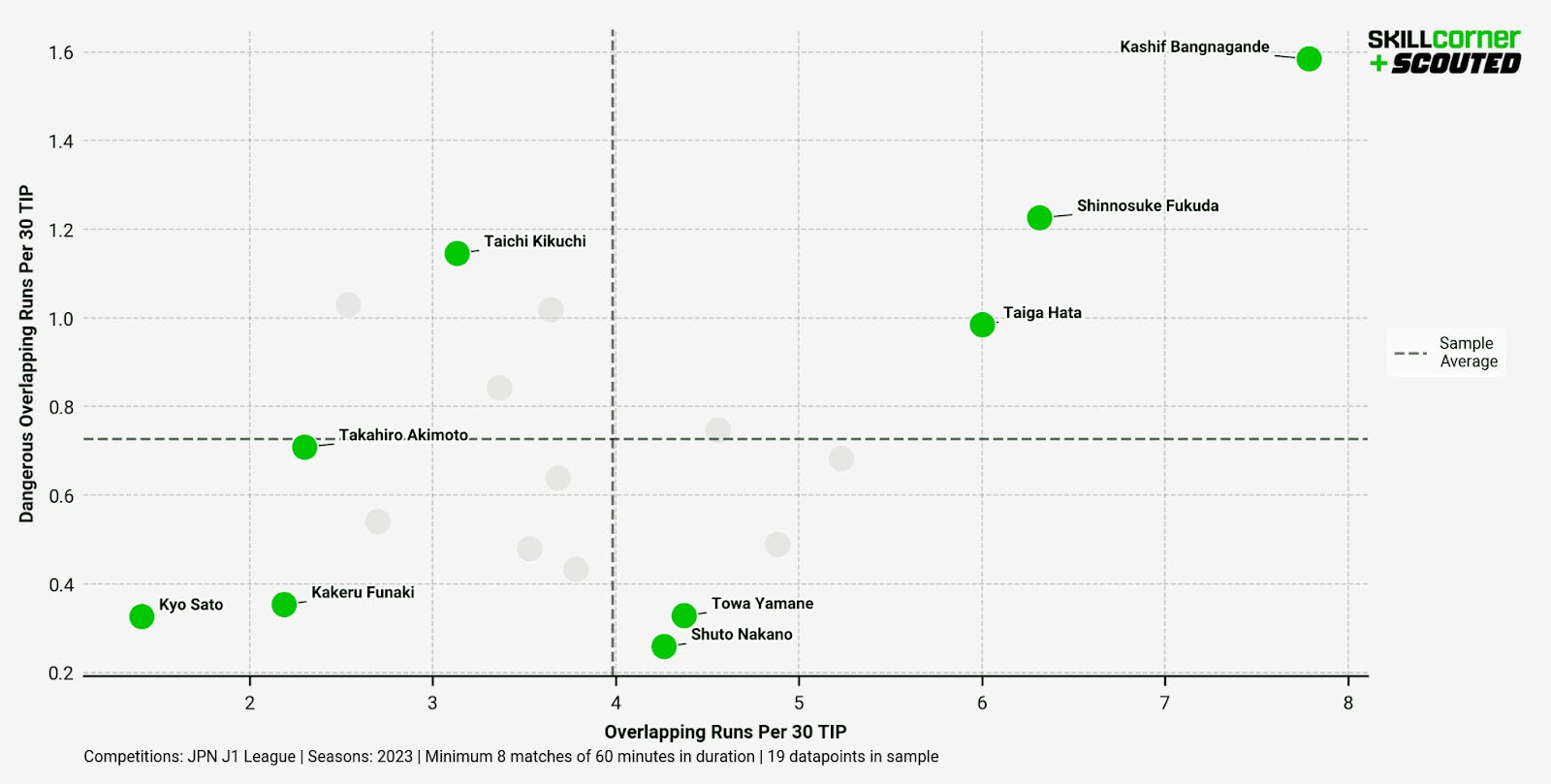
When we plot the data of the young, overlapping full-backs of the J.LEAGUE from the 2023 season, then there’s two that catch the eye: Kashif Bangnagande of FC Tokyo and Kyoto Sanga’s Shinnosuke Fukuda. They’re in a league of their own in terms of frequency and danger, with Shonan Bellmare’s Taiga Hata the only one that gets close.
Both are players that have been on my radar since last season, one more so than the other. The brilliantly-named Bangnagande has played over 70 times for Tokyo since his debut in 2020 despite suffering from a few different injuries. He’s already a senior Japan international at 22 years old.
Fukuda personifies the idiosyncrasies of the Japanese football system. The 2023 season was his first in senior football at the age of 23, having left academy football to complete a degree (and play football) at Meiji University. Despite that, he caught the eye in the second half of the season for Kyoto Sanga. I really liked him when I watched him against Yokohama F Marinos; his athleticism immediately grabbed my attention, as did his punchy and positive presence up and down the right flank on both sides of the ball.
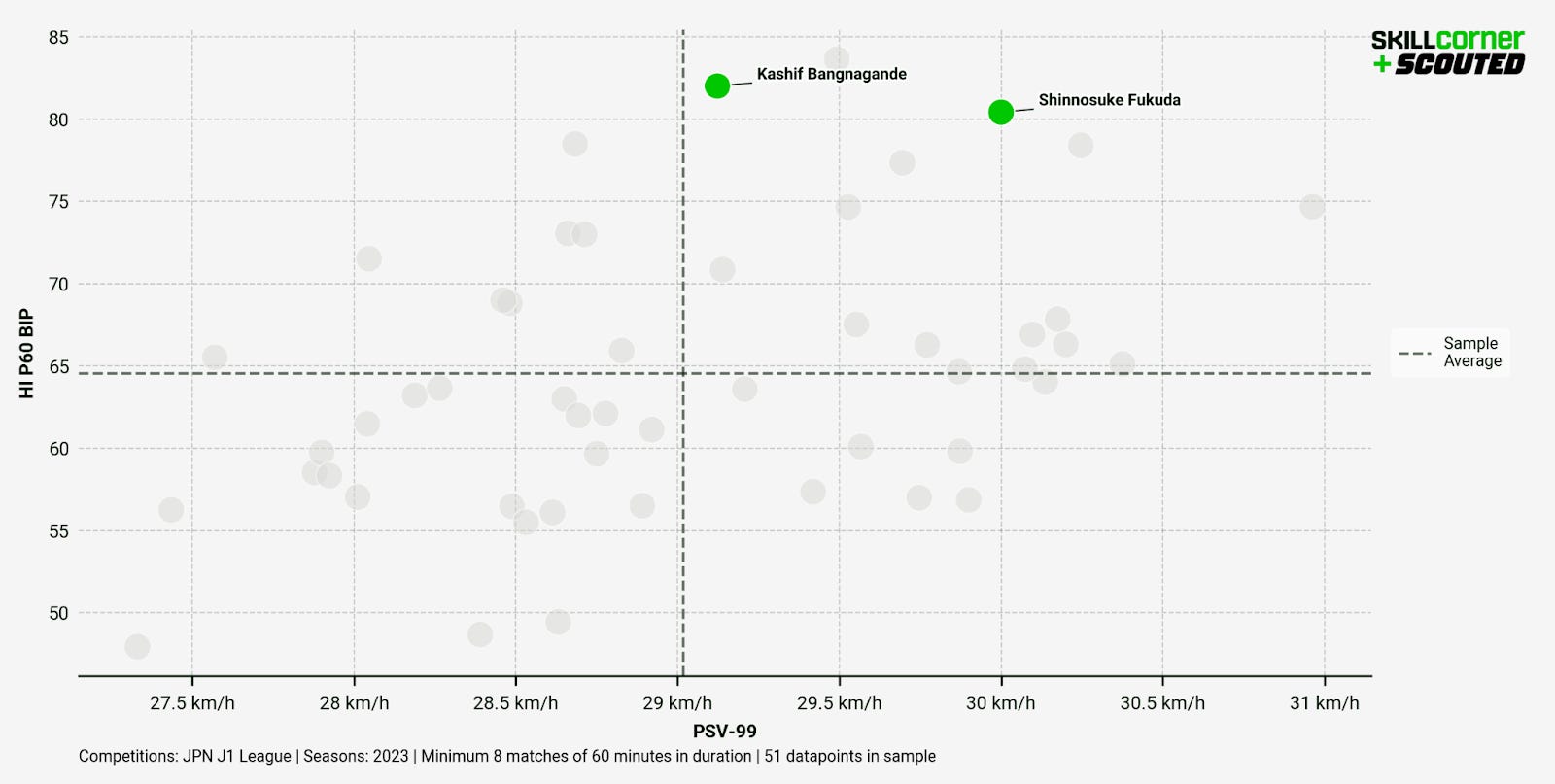
With that in mind, it’s good to see that Fukuda was one of the three-most athletic full-backs in the J.LEAGUE last season when it comes to intense runs and top-line speed – and Bangnagande wasn’t far off him either. This is the standard of athleticism that should give European clubs security when assessing whether they can stick the leap to European football.
4. A run-making centre-forward
Goalscorers are important, but the profile of a (primary) goalscorer has shifted a lot over the past decade. Dominant centre-forwards gave way for the super-dynamic, uber-efficient wide forwards, and now it seems to be shifting back toward the more traditional focal point types.
In terms of emerging centre-forwards in the Japanese game, Mao Hosoya is probably the most prominent and promising. He’s already racked up over 130 appearances for Kashiwa Reysol – which is good going given the typical timeline of young players in Japan – and he was the fifth-top goalscorer in the J.LEAGUE last season with 14 goals in 2,800 minutes.
Instead of using SkillCorner data to find a young centre-forward, I used it to validate the qualities of Hosoya.
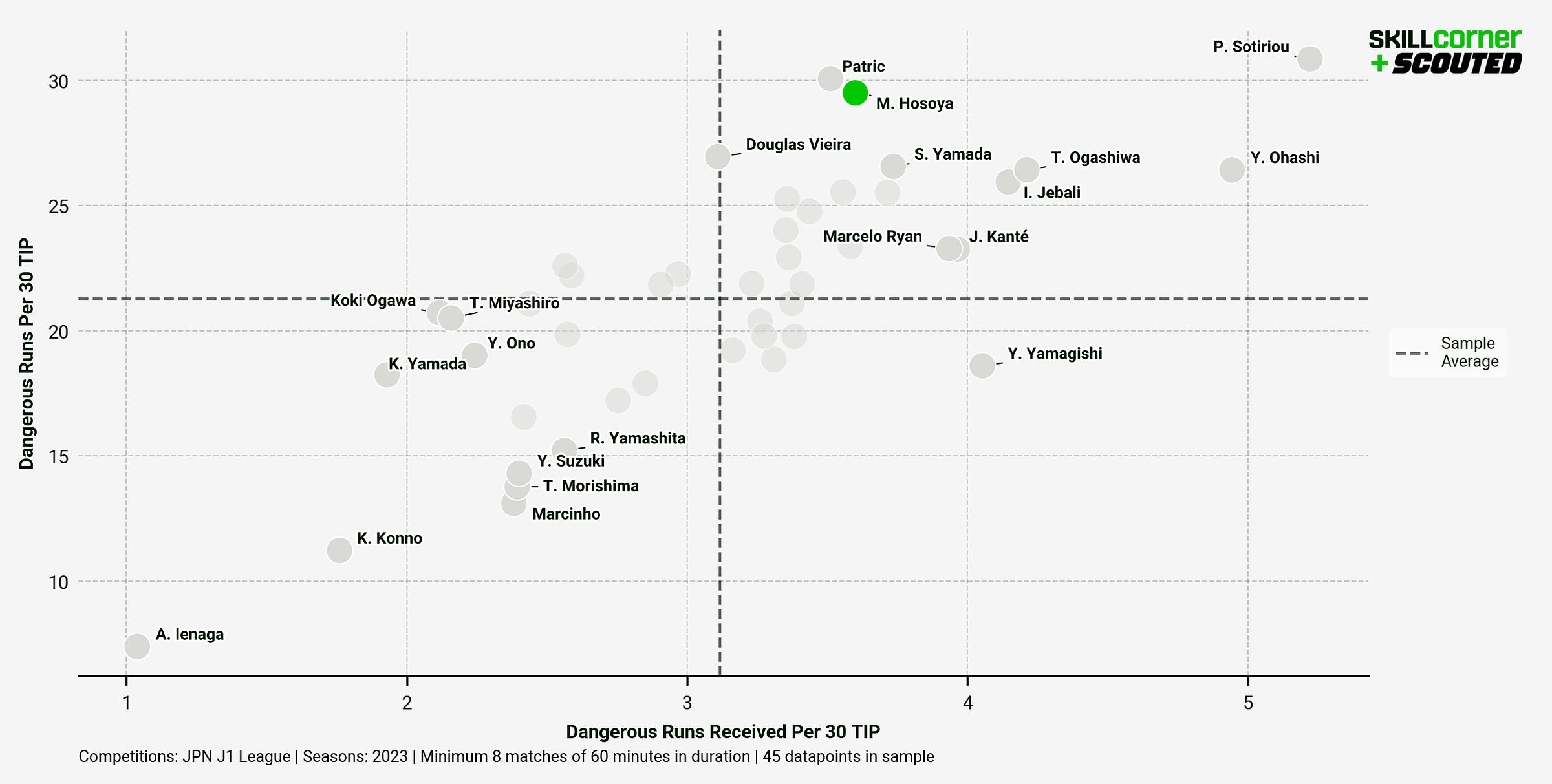
And as you can see, the 22-year-old Hosoya shows up well in terms of making and receiving dangerous runs. He competes with the best in Pieros Sotiriou – a Cypriot striker with decent goalscoring pedigree across Europe, whose data may be inflated by a small sample size of only 900 minutes – by making almost 30 dangerous runs per 30 minutes TIP and receives more than enough given he plays for a side that only escaped relegation by four points.
The beauty of the SkillCorner suite is you can get specific with it. With a few clicks, I could delve deeper into the type of dangerous runs Hosoya makes, adding even more layers to the data.
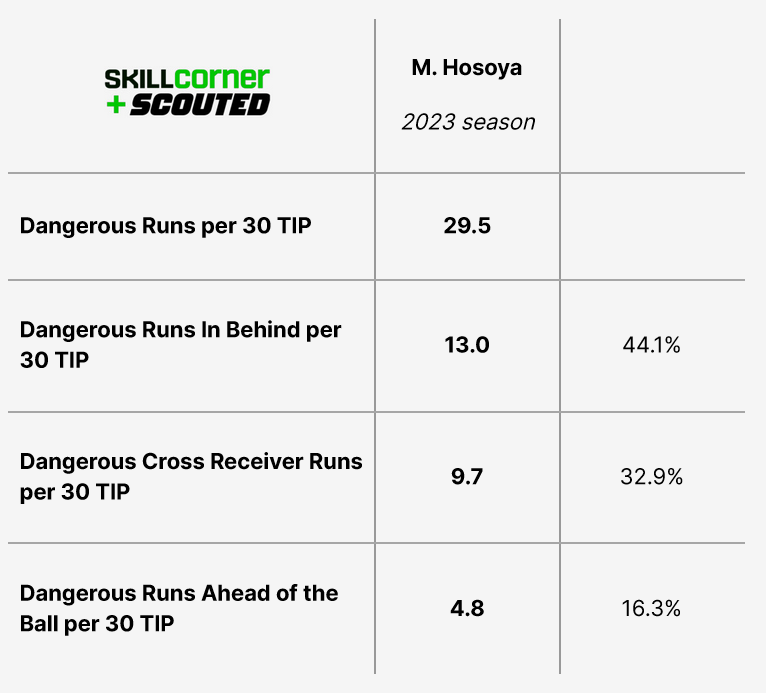
Almost half of his 29.5 dangerous runs per 30 TIP were runs in behind the defensive line and a third were cross receiver runs. Those are pretty self explanatory, and it tallies with the video when you watch his shots from the 2023 season on WyScout (sadly, other scouting tools are not available).
One of the most eye-catching things when you watch Hosoya is how he runs in behind. Playing for a weaker side means he gets a lot of opportunities to do so in transition, but he doesn’t do it by hanging off the back shoulder and latching onto balls into space – he (often) does it by starting from a little deeper and running straight through the two centre-backs, a method that’s a little strange.
Watch the clips and you’ll notice he’s selfish when it comes to attacking crosses into the box too – but in the good I’m-a-centre-forward-and-I-want-to-score-goals way. Strikers are taught to attack either of the posts in crossing situations to free up space for those arriving from behind, but Hosoya likes to drop off the defensive line looking for low cut-backs, and he’s scored quite a few in those situations.
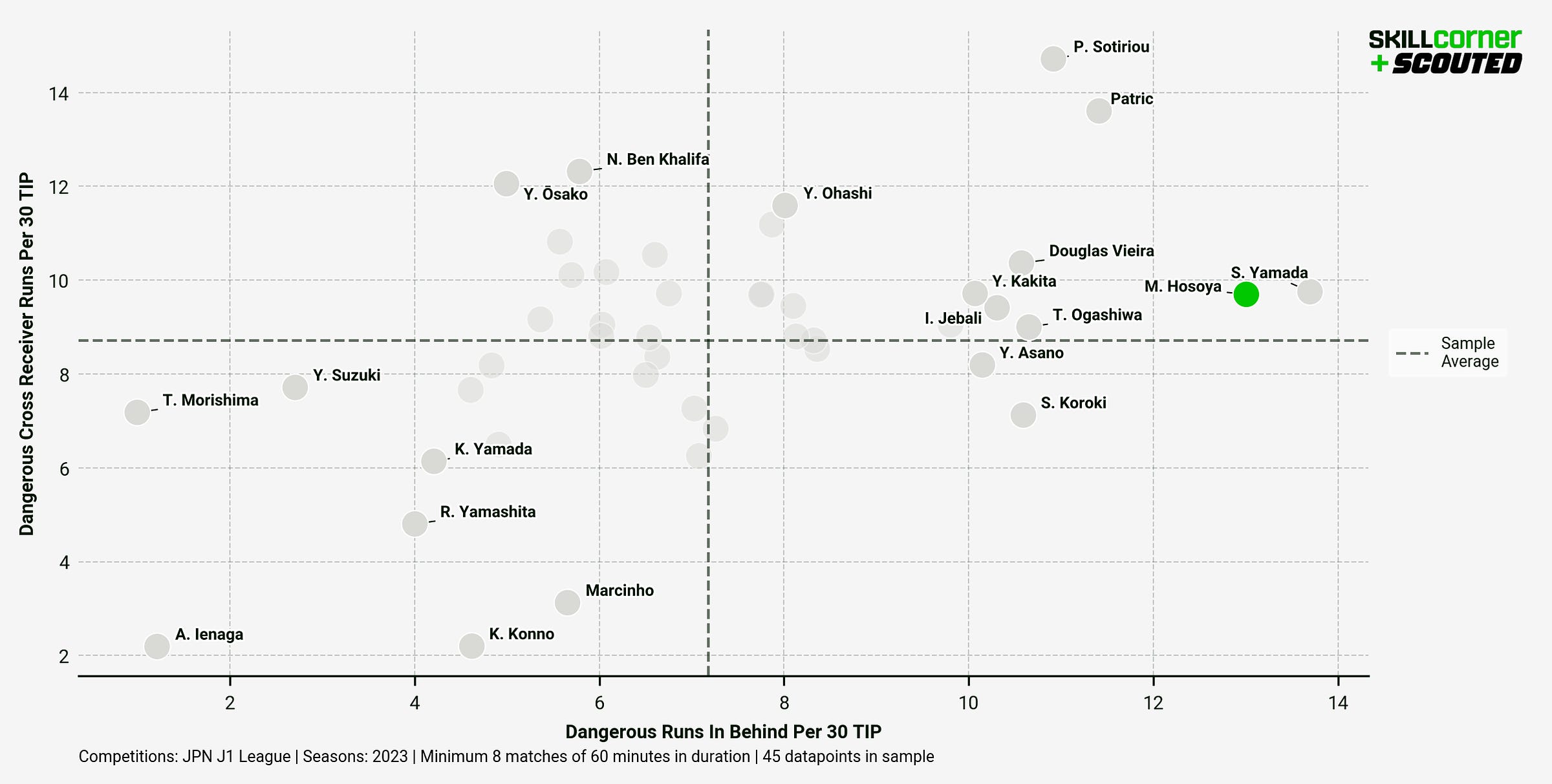
If you’re looking for a striker that makes dangerous runs, then SkillCorner data shows that Hosoya is one of the best in the J.LEAGUE at it. If you’re looking for a striker that makes dangerous runs in behind and in the box, then SkillCorner data shows that Hosoya should be on your shortlist.
What have we gleaned from this? The biggest takeway, following on from Stevie’s Revolution Asia piece, is that the J.LEAGUE is closer to the standards of the elite-level European game than you probably thought.
That statistical fact should make the best emerging J.LEAGUE talent even more enticing for those in Europe, particularly while the market is more accessible to those clubs further down the food chain. Belgian clubs have shown how much value there is in Japanese football, as have Brighton.
You can expect to see most of the players in this piece making the leap to Europe before long — and they have a great chance of sticking the landing.
Written by Llew Davies.
Click here for more information on our football products.
Click here for more of Scouted's writing on emerging football talent.